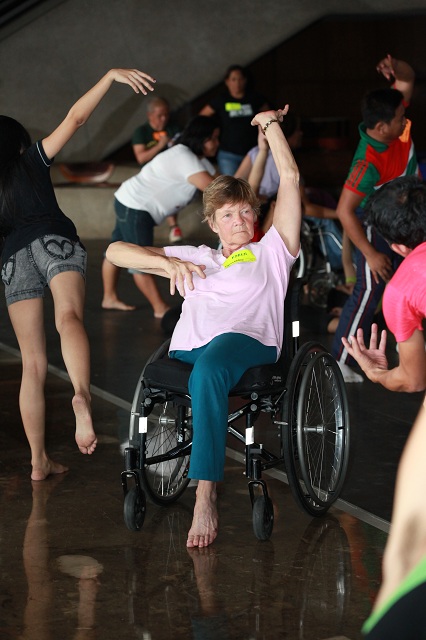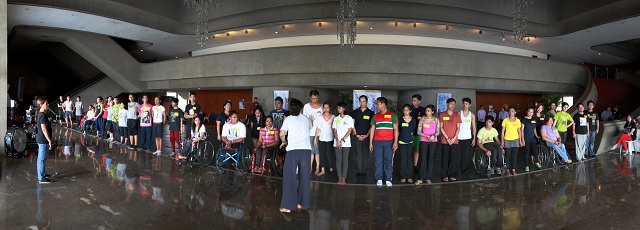Dancing with disability
“Just because of a little bit of touch. It was a very powerful experience to see that something so small can change somebody’s whole reality of space or ability to move around. Everything can change—because somebody accepts you for what you are and then allows you to express yourself.” This is how Karen Daly, a person with disability, described her first experience dancing with an able-bodied person, leaving her wheelchair behind. Karen was eight years old when she lost her right leg to cancer. At the time, dancing was far from her mind. But some 20 years later, a trapeze performance by a crippled man fired her passion in dancing. “At first, I was extremely prejudiced about disabled people even though I am one… But then I realized, how can that be, that I feel that way? I am one of these people,” Karen told GMA News Online after participating in a workshop at the Cultural Center of the Philippines’ Bulwagang Amado Hernandez. Fast forward to 2013, and Karen is now a certified dancer and teacher with DanceAbility International, an organization that seeks to bring people with and without disabilities together through dance.  Last week, DanceAbility provided a five-day workshop for Filipino dancers, artists and teachers with “mixed abilities”—some were in wheelchairs, while others were deaf or blind. “The intention is moving together and finding new things out about yourself and the other person as you do it—and hopefully make something beautiful,” said Karen.
Last week, DanceAbility provided a five-day workshop for Filipino dancers, artists and teachers with “mixed abilities”—some were in wheelchairs, while others were deaf or blind. “The intention is moving together and finding new things out about yourself and the other person as you do it—and hopefully make something beautiful,” said Karen. This reporter was privileged to attend one of the workshops, and the performance was a tearjerker, especially when one crippled man, passionately dancing, let go of his wheelchair and danced without the aid of it. It was magical when Karen, at one point, stood upright with just one foot. The choreography went crazy, with able-bodied people trying to create different positions in the wheelchair of their respective partners, and the disabled persons matching their enthusiasm by moving around the space carrying their partners. The venue was full of energy, with everybody challenging themselves, pushing themselves to their limits, and just enjoying the dance with their partners.
 A lesson in dancing: Equality “It is easier to teach dance to able-bodied people but it is not as interesting,” said DanceAbility’s artistic director and founder Alito Alessi. HIs students through the years included people with diverse disabilities, and sometimes disabilities so severe that they were fed through tubes. “Someone’s physical or mental abilities are not problems. The problems are when those people are isolated on other people and society. So, our main point is to bring out isolation,” he told GMA News Online in a separate interview. “Dancing is a vehicle to represent equality for all people,” he added.
A lesson in dancing: Equality “It is easier to teach dance to able-bodied people but it is not as interesting,” said DanceAbility’s artistic director and founder Alito Alessi. HIs students through the years included people with diverse disabilities, and sometimes disabilities so severe that they were fed through tubes. “Someone’s physical or mental abilities are not problems. The problems are when those people are isolated on other people and society. So, our main point is to bring out isolation,” he told GMA News Online in a separate interview. “Dancing is a vehicle to represent equality for all people,” he added. Workshop participants Christian Apolinario, 28, and Razel Ann “Xiao” Mitchao, 23, concurred with Alito. Christian, who has been crippled since childhood, said that the workshop has been an unforgettable experience. Although he had previously joined dance sport for people in wheelchairs, it was his first dance workshop with able-bodied people. “Sobrang masaya po siya. Nararamdama mo kasi ‘yung equality… Never ka nilang dinegrade. Ang sasabihin nila sa iyo, you can do that. So, parang sila nagbibigay ng motivation,” he said. Xiao, an associate artistic director for Dance Pull School of Performing Arts in Bacolod City, said said that this was her first time to dance with people with disabilities. “‘Yung feeling na we are just all the same, na you don’t have to think na they are disabled people, kasi kahit sila tingin nila normal din sila so parang ang saya lang, ang sarap ng feeling na magkasama kami sa workshop na ito,” she added. Xiao also noted that she was surprised to learn that some PWDs can do some extreme choreography. The most valuable lesson she learned from the workshop: “Pantay-pantay tayong lahat. Kahit may kulang sa body parts mo...Pare-pareho tayo kasi kahit tayong able-bodied person may mga kulang din sa atin e.” Because everybody can dance Alito explained that “mixed ability” dancing was rooted from contemporary dancing, with the philosophy that “everybody can dance.” “It sort of grew on a tail of the Contemporary Dance Festival and it just exploded over the years. It is its time now; in the beginning it was ahead of its time,” he said.
Asked for his motivation to continue what has become an international movement, he said, “I was touched… I have learned that somebody’s physical condition or mental unique characteristic—those are not problems. Those are situations that present themselves that give you an opportunity to learn.” Operating in 37 countries, DanceAbility is now seen as a worldwide movement pioneering in developing mixed abilities. What it hopes to show, said Alito, is that problems arise when you categorize people and separate them. “Problems come when you try to put all the blind there, the deaf there… You are creating impossible situations, which is not reality. They are not natural. Problems arise when you go against nature,” he said. “Once you have everybody together, you have the higher possibility of learning.” — BM, GMA News Photos courtesy of the US Embassy.




